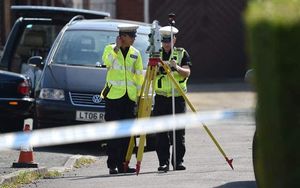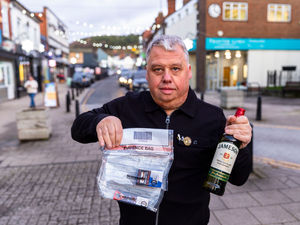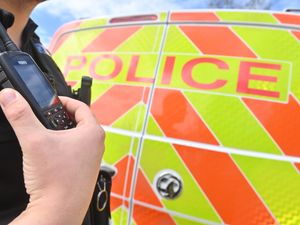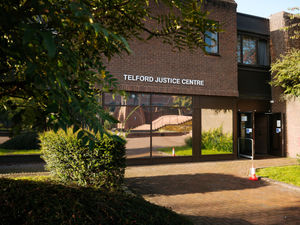Dalian Atkinson had no defensive injuries to hands or forearms, jury hears
Ex-Aston Villa star Dalian Atkinson had no defensive injuries to his hands or forearms after he was Tasered and allegedly subjected to a fatal attack by a police constable, a court has heard.
A trial at Birmingham Crown Court was told post-mortem examinations found Mr Atkinson, aged 48, died of a cardiorespiratory arrest following the deployment of a Taser "followed by a brief period of restraint and blunt force trauma".
West Mercia Pc Benjamin Monk denies murdering Mr Atkinson, while his colleague and then partner Pc Mary Ellen Bettley-Smith denies assaulting the 48-year-old prior to his death in the Trench area of Telford in August 2016.

Both officers maintain that they acted lawfully towards Mr Atkinson, who was Tasered for 33 seconds, kicked at least twice in the head and struck with a police baton.
During the Crown's opening of the case, prosecutor Alexandra Healy QC said the pathologist had examined injuries but "no typical defence wounds" were noted to the hands or forearms of Mr Atkinson, who also played for Ipswich Town and Sheffield Wednesday.
Coverage of the case:
Although minor injuries were found on his right hand, they were consistent with having been caused by broken glass from punching a door window, the court heard.
Giving jurors a summary of the pathologist's findings, Ms Healy added: "There were some 14 areas of subcutaneous and in some cases intramuscular bruising which, in his view, all represent blunt force trauma.
"Given that many of these areas were on the back of his body and legs on the side that would have been exposed and therefore presenting itself to the officers, it's possible those 14 areas do represent bruising caused by baton strikes.
"However, in his view, these injuries would not have materially contributed to or directly caused death."

Jurors were informed that the prosecution had also instructed an expert in intensive care medicine and a second pathologist to consider the case.
All three of the prosecution's medical experts, the court was told, agreed that while Mr Atkinson's enlarged heart meant that he could have died at any time, the prolonged period of Tasering and the kicks to his head made a "significant contribution" to his death.
Explaining the Crown's submissions about the implications of the alleged assault, Ms Healy said: "The three experts agreed that at some stage in the events, after the third deployment of the Taser, Dalian Atkinson became unconscious.
"They were in no doubt that being rendered unconscious made a significant contribution to his death.
"The three prosecution experts were agreed that the longer the Tasering went on for, the greater its causative significance because the period it will have had a harmful impact on Dalian Atkinson's breathing will have been longer.
"In their view the most likely explanation for Dalian Atkinson's unconsciousness is the kicks to the head."
Terrified
Meanwhile, the QC acting for Pc Monk has said the officer does not dispute kicking the ex-footballer twice in the head - but he only did so while he was "terrified."
In an address to the court immediately after the Crown's opening speech, defence QC Patrick Gibbs urged jurors to keep an open mind until they had heard all the evidence against Pc Benjamin Monk.
The trial has heard Mr Atkinson, who played for Aston Villa, Sheffield Wednesday and Ipswich Town, was Tasered for 33 seconds and had two bootlace prints on his forehead when he was taken to hospital.
After submitting that Mr Atkinson had been a "good person and a much-loved person" who was extremely unwell in 2016, causing him to act uncharacteristically, Mr Gibbs told the court: "It is not in dispute that Mr Monk must have kicked Dalian Atkinson twice in the head.
"That is the only explanation for the marks on his forehead.
"What is in dispute is why did he do that? He has always said he was terrified and that Mr Atkinson, after that third Taser (use) had been effective, initially at least, he was trying to get up."
Mr Gibbs told jurors Mr Atkinson's death was "multi-factorial" and the medical evidence was "amongst the most complex, if not the most medically complex, forensic pathology case" that a pathologist involved in the case had dealt with.
The barrister said the medical evidence would take at least a week to set out.
Key events
Urging the jury to keep an open mind until they had heard all the evidence, Mr Gibbs added: "The key events took six minutes. Mr Monk and Miss Bettley-Smith arrived in Meadow Close at 1.36am.
"The third Taser cartridge was fired five minutes after that, at 1.41am.
"Mr Monk and Miss Bettley-Smith are said to have acted lawfully, everyone agrees, for those first five minutes.
"But they're then accused of having acted unlawfully in the sixth minute.
"Another of the important things I suggest you will have to decide is whether that distinction is either realistic, or fair, actually."
Richard Smith QC, Bettley-Smith's barrister, said: "Miss Bettley-Smith has said and continues to say that the use of the baton by her was lawful.
"The baton was not used in anger after what had gone before.
"But rather she delivered blows to the lower half of Mr Atkinson because she genuinely believed, in the heat of the moment, in the circumstances she found herself in, that the use of that baton was necessary and reasonable.
"Necessary and reasonable as part of her and Mr Monk's continuing efforts to restrain and detain an unpredictable and threateningly violent man as she perceived him to be."
The case continues.





